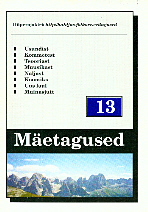Suur tamm ja õde-venda
The Great Oak and the Brother and Sister
Author(s): Aado LintropSubject(s): Customs / Folklore
Published by: Eesti Kirjandusmuuseum
Summary/Abstract: As my previous article on Balto-Finnic folksongs concerning the motif of the Great Oak (The Great Oak, the Weaving Maidens and the Red Boat, Not to Mention a Lost Brush, Folklore 11) failed to explain the reasons why the tree which swept the clouds cannot be considered the Great World Tree, I will begin by comparing different concepts about large trees. I will not limit the comparison to searching parallels and opposites to the Great Oak only. The motif of the giant tree intersected a wide circle of questions already in my previous article. I will also discuss the mythological couple of brother and sister, the central characters in Estonian runic and regi-songs, not with an intention to unveil their «true mythological nature», but with a hope to point out some important facts on them. The Great World Tree is usually depicted as a huge, often exuberant or opulent tree with a certain number of branches. The size and colour of the leaves are often specifically mentioned. The bark of the tree is exceptional, and the fruits, if mentioned at all, are large. The tree is often located in a specific mythical place, in the centre of a continent, for example. The Great World Tree is commonly associated to celestial bodies, which were either resting on its branches or revolving around its top. The world tree is often equalled with a Tree of Life: in some songs his fruits are the source of immortality, in others the tree grows near a spring or well of the water of life. The fate of mankind may be inscribed on its leaves. The Great World Tree is often the abode of some winged mythical creature. Like a snake, which lives near the world tree or under its roots and is the symbol of the underworld, so is the winged being, which lives on top of the tree, the symbol of the heavenly kingdom. Unlike other texts describing the Great World Tree, the Balto-Finnic song focuses on the creation of the tree (it is planted in one way or another by impersonal mythological characters) and the chopping of the tree. But neither of the other mentioned texts about the Great World Tree mentions its origin or destruction. Distinct from the oak or pillar found in the chain-songs, the Great Oak does not support or hold the sources of celestial light, but with its fast growth threatens to break up the sky and block the clouds from moving. Therefore, by shielding the light from the celestial bodies it is the opposite of the world tree, and as such is analogous with the Sumerian huluppu tree.
Journal: Mäetagused. Hüperajakiri
- Issue Year: 2000
- Issue No: 13
- Page Range: 24-42
- Page Count: 19
- Language: Estonian

